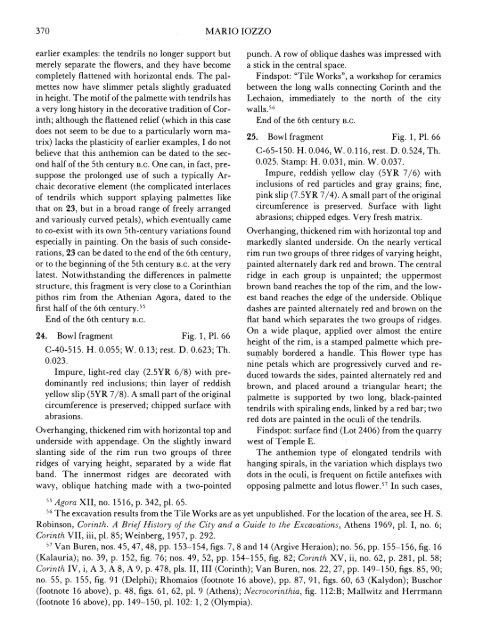f - The American School of Classical Studies at Athens
f - The American School of Classical Studies at Athens
f - The American School of Classical Studies at Athens
Create successful ePaper yourself
Turn your PDF publications into a flip-book with our unique Google optimized e-Paper software.
370 MARIO IOZZO<br />
earlier examples: the tendrils no longer support but<br />
merely separ<strong>at</strong>e the flowers, and they have become<br />
completely fl<strong>at</strong>tened with horizontal ends. <strong>The</strong> pal-<br />
mettes now have slimmer petals slightly gradu<strong>at</strong>ed<br />
in height. <strong>The</strong> motif <strong>of</strong> the palmette with tendrils has<br />
a very long history in the decor<strong>at</strong>ive tradition <strong>of</strong> Cor-<br />
inth; although the fl<strong>at</strong>tened relief (which in this case<br />
does not seem to be due to a particularly worn ma-<br />
trix) lacks the plasticity <strong>of</strong> earlier examples, I do not<br />
believe th<strong>at</strong> this anthemion can be d<strong>at</strong>ed to the sec-<br />
ond half <strong>of</strong> the 5th century B.C. One can, in fact, pre-<br />
suppose the prolonged use <strong>of</strong> such a typically Ar-<br />
chaic decor<strong>at</strong>ive element (the complic<strong>at</strong>ed interlaces<br />
<strong>of</strong> tendrils which support splaying palmettes like<br />
th<strong>at</strong> on 23, but in a broad range <strong>of</strong> freely arranged<br />
and variously curved petals), which eventually came<br />
to co-exist with its own 5th-century vari<strong>at</strong>ions found<br />
especially in painting. On the basis <strong>of</strong> such conside-<br />
r<strong>at</strong>ions, 23 can be d<strong>at</strong>ed to the end <strong>of</strong> the 6th century,<br />
or to the beginning <strong>of</strong> the 5th century B.C. <strong>at</strong> the very<br />
l<strong>at</strong>est. Notwithstanding the differences in palmette<br />
structure, this fragment is very close to a Corinthian<br />
pithos rim from the Athenian Agora, d<strong>at</strong>ed to the<br />
first half <strong>of</strong> the 6th century.55<br />
End <strong>of</strong> the 6th century B.C.<br />
24. Bowl fragment Fig. 1, P1. 66<br />
C-40-515. H. 0.055; W. 0.13; rest. D. 0.623; Th.<br />
0.023.<br />
Impure, light-red clay (2.5YR 6/8) with pre-<br />
dominantly red inclusions; thin layer <strong>of</strong> reddish<br />
yellow slip (5YR 7/8). A small part <strong>of</strong> the original<br />
circumference is preserved; chipped surface with<br />
abrasions.<br />
Overhanging, thickened rim with horizontal top and<br />
underside with appendage. On the slightly inward<br />
slanting side <strong>of</strong> the rim run two groups <strong>of</strong> three<br />
ridges <strong>of</strong> varying height, separ<strong>at</strong>ed by a wide fl<strong>at</strong><br />
band. <strong>The</strong> innermost ridges are decor<strong>at</strong>ed with<br />
wavy, oblique h<strong>at</strong>ching made with a two-pointed<br />
punch. A row <strong>of</strong> oblique dashes was impressed with<br />
a stick in the central space.<br />
Findspot: "Tile Works", a workshop for ceramics<br />
between the long walls connecting Corinth and the<br />
Lechaion, immedi<strong>at</strong>ely to the north <strong>of</strong> the city<br />
walls."6<br />
End <strong>of</strong> the 6th century B.C.<br />
25. Bowl fragment Fig. 1, P1. 66<br />
C-65-150. H. 0.046, W. 0.116, rest. D. 0.524, Th.<br />
0.025. Stamp: H. 0.031, min. W. 0.037.<br />
Impure, reddish yellow clay (5YR 7/6) with<br />
inclusions <strong>of</strong> red particles and gray grains; fine,<br />
pink slip (7.5YR 7/4). A small part <strong>of</strong> the original<br />
circumference is preserved. Surface with light<br />
abrasions; chipped edges. Very fresh m<strong>at</strong>rix.<br />
Overhanging, thickened rim with horizontal top and<br />
markedly slanted underside. On the nearly vertical<br />
rim run two groups <strong>of</strong> three ridges <strong>of</strong> varying height,<br />
painted altern<strong>at</strong>ely dark red and brown. <strong>The</strong> central<br />
ridge in each group is unpainted; the uppermost<br />
brown band reaches the top <strong>of</strong> the rim, and the low-<br />
est band reaches the edge <strong>of</strong> the underside. Oblique<br />
dashes are painted altern<strong>at</strong>ely red and brown on the<br />
fl<strong>at</strong> band which separ<strong>at</strong>es the two groups <strong>of</strong> ridges.<br />
On a wide plaque, applied over almost the entire<br />
height <strong>of</strong> the rim, is a stamped palmette which pre-<br />
supably bordered a handle. This flower type has<br />
nine petals which are progressively curved and re-<br />
duced towards the sides, painted altern<strong>at</strong>ely red and<br />
brown, and placed around a triangular heart; the<br />
palmette is supported by two long, black-painted<br />
tendrils with spiraling ends, linked by a red bar; two<br />
red dots are painted in the oculi <strong>of</strong> the tendrils.<br />
Findspot: surface find (Lot 2406) from the quarry<br />
west <strong>of</strong> Temple E.<br />
<strong>The</strong> anthemion type <strong>of</strong> elong<strong>at</strong>ed tendrils with<br />
hanging spirals, in the vari<strong>at</strong>ion which displays two<br />
dots in the oculi, is frequent on fictile antefixes with<br />
opposing palmette and lotus flower.57 In such cases,<br />
55 Agora XII, no. 1516, p. 342, pl. 65.<br />
56 <strong>The</strong> excav<strong>at</strong>ion results from the Tile Works are as yet unpublished. For the loc<strong>at</strong>ion <strong>of</strong> the area, see H. S.<br />
Robinson, Corinth. A Brief History <strong>of</strong> the City and a Guide to the Excav<strong>at</strong>ions, <strong>Athens</strong> 1969, pl. I, no. 6;<br />
Corinth VII, iii, pl. 85; Weinberg, 1957, p. 292.<br />
5 Van Buren, nos. 45, 47, 48, pp. 153-154, figs. 7, 8 and 14 (Argive Heraion); no. 56, pp. 155-156, fig. 16<br />
(Kalauria); no. 39, p. 152, fig. 76; nos. 49, 52, pp. 154-155, fig. 82; Corinth XV, ii, no. 62, p. 281, pl. 58;<br />
Corinth IV, i, A 3, A 8, A 9, p. 478, pls. II, III (Corinth); Van Buren, nos. 22, 27, pp. 149-150, figs. 85, 90;<br />
no. 55, p. 155, fig. 91 (Delphi); Rhomaios (footnote 16 above), pp. 87, 91, figs. 60, 63 (Kalydon); Buschor<br />
(footnote 16 above), p. 48, figs. 61, 62, pl. 9 (<strong>Athens</strong>); Necrocorinthia, fig. 112:B; Mallwitz and Herrmann<br />
(footnote 16 above), pp. 149-150, pl. 102: 1, 2 (Olympia).

















